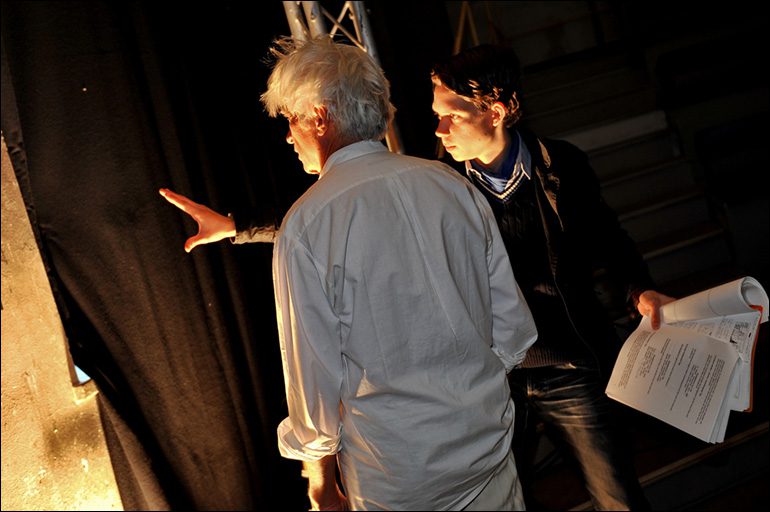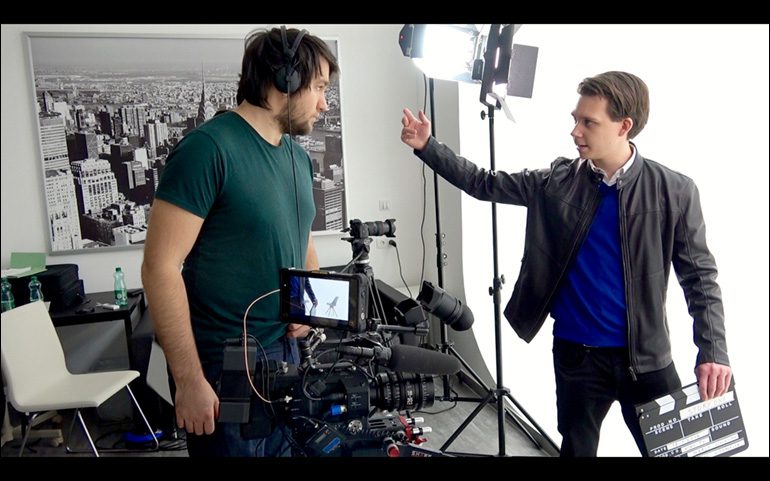by Marco Schleicher, MA

The technique I use helps me to be precise, efficient and to add more depth to a scene. At the same time, I try to be open to new ideas, and I like the actors to offer me something.
I have a 4-Step Method how I break down scenes. This method forces you to think about each detail and helps you to get a clear vision of what you want. It is based on what I have learned at Michael Haneke’s Directing Program (Film Academy Vienna), during my MA in Directing (Met Film School London) and at a theatre directing course (Royal Central School of Speech and Drama).
In the following article, I will break down a scene from my MA graduation film, “The Talent Agent”, which I shot in London starring Christian McKay (known as Orson Welles in Richard Linklater’s “Me and Orson Welles”). The film is about a talent agent, who wants to drive his star into suicide to commercialize the star’s death.
In the chosen scene, the talent agent (Jeff) shows his star (Amber) a room full of fan products of her. Then he gives her a press release which says that she committed suicide that very night.
Before I break down a scene, I read it through carefully. Then I start with adding the turning points.
Step 1: Turning Points
What is a turning point? A turning point is the moment where a situation is changing emotionally. Let me give you an example: a man is happy, then he hears that his dog died and he gets sad. The turning point is the small moment in between the emotion happy and sad.
The chosen scene from my graduation film has 3 turning points:
- When Amber sees the fan products of her
- When Amber understands that she has to die
- When Jeff shows Amber that he is serious about it
I add the turning points on the right side of the script next to the moment where the situation is changing. I call the turning points, “TP”, and put them into a circle so that it is easy to see them. When Amber reads the press release and understands that she has to die, it looks like this:
Step 2: Beats
A beat is a part of the scene. It unites an emotion or a theme. A turning point marks the moment where a beat ends and a new one begins. Generally, I try to find an overall emotion for each beat. I add the emotion of a beat on the left side of the script.
Together with the emotion, also the speed is changing. The speed tells us how fast the characters are interacting with each other. I add the speed on the left side of the script below the emotion of a beat. The speed can be described as: slow, slower, normal speed, faster or fast.
It is good to know the speed as a director, but I wouldn’t tell it necessarily to the actors. In my opinion, it is better to give the actors a reason to be fast or slow rather than just telling them the final result. With the beats added, the beginning of my scene looks like this:
Step 3: Subtext
What is the subtext? The subtext is what a person is actually thinking or feeling. It influences the tone how a line is spoken. I add the subtext next to every line of the script. Usually, I describe it in the following ways:
You can write down emotions, like angry, aggressive, nervous, happy, excited etc. Another way is to add adjectives – they can also tell us more about the strategy of a character – like friendly, light, convincing etc. Alternatively, you can write down what the characters are actually thinking, like, “Is this real?!”. At this stage, you can also add, “pause”, or “short pause”, at moments, where the scene requires some silence.
Step 4: Basic Information
I conclude the breakdown with writing down some basic information about the scene. First, I write down the motivation of the main characters. The motivation tells us what the characters want to achieve within a scene. In the scene from my graduation film, Jeff wants to tell Amber that she has to kill herself and Amber wants to find out what is going on.
Next, I write down the arc of the scene. It tells us where the characters emotionally start and where they end. In my scene, I just wrote down one arc for both characters since their emotions are quite similar; they go from excited to serious.
Finally, I write down what happened before and in what kind of emotional state the characters already are. This is important for the intensity and the stakes of the scene. In my scene, Jeff and Amber just had some drinks. Jeff is nervous if his plan will work out. Amber expects to sleep with Jeff now. I write the basic information next to the beginning of the scene, and it looks like this:
This method takes me about 20 minutes per page. It is time consuming, but it really helps you to understand a scene and what it is about. It also gives you answers to many questions the actors may ask.
Despite all planning, I think it is important to stay spontaneous and flexible if new ideas come up on set. Careful preparation gives me the freedom to respond to new thoughts and to adapt them to my vision. My final breakdown looks like this:
About the Author: Marco Schleicher is an Austrian filmmaker and a former student from Michael Haneke. In London, he completed his MA in Directing. Besides writing and directing his own projects, Marco works in the Assistant Director and Casting department. He worked on Blockbuster movies -‐ including “Terminator” and “Hellboy” -‐ as well as on TV series for Netflix and Amazon. Further information can be found on his website: www.marco-schleicher.at.












